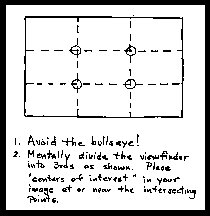

One of the things you'll see in lots of photographs, whether they are professionally done magazine ads or amatuer camera club competition entries, is the observance of the Rule of Thirds. The image plane is divided both horizontally and vertically by three and, where the dividing lines intersect, you'll have points that seem to be the natural place for the center, or centers, of interest for your images. Consider the following...
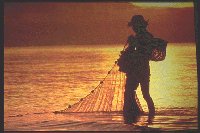 Here,
a man is the main subject and is, certainly, a center of interest. He is
tending his net, looking down towards its other end which, perhaps, can
be thought of as a secondary center of interest. Your own curiousity might
lead you to look there to see what he's pulling up in his net. The man
and the net are positioned in the image plane so that his head and shoulder
are at the upper, rightmost one-third intersection, and the net flows to
the lower, leftmost one.
Here,
a man is the main subject and is, certainly, a center of interest. He is
tending his net, looking down towards its other end which, perhaps, can
be thought of as a secondary center of interest. Your own curiousity might
lead you to look there to see what he's pulling up in his net. The man
and the net are positioned in the image plane so that his head and shoulder
are at the upper, rightmost one-third intersection, and the net flows to
the lower, leftmost one.
Bullseyes are images that clearly violate the Rule of Thirds.
Such pictures have one center of interest squarely in, or near, the middle
of the image plane. Very often, these images are boring.
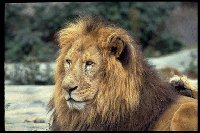 This
lion's face is placed near the middle of the image, on the bullseye. In
addition to other minor flaws, like a distracting, bright background, this
bullseye treatment is uninteresting.
This
lion's face is placed near the middle of the image, on the bullseye. In
addition to other minor flaws, like a distracting, bright background, this
bullseye treatment is uninteresting.
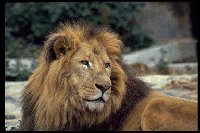 Let's
look at the same subject shifted over a bit - conforming more to the Rule
of Thirds - with its face and mane aligned with the leftmost, one-third
dividing line. We have a better picture. It's sometimes just this simple,
a minor viewfinder adjustment. Might the picture have been even better
with the lion's eye (eyes are natural centers of interest) at the upper,
leftmost one-third intersecting point? Maybe. Let's crop and see what happens...
Let's
look at the same subject shifted over a bit - conforming more to the Rule
of Thirds - with its face and mane aligned with the leftmost, one-third
dividing line. We have a better picture. It's sometimes just this simple,
a minor viewfinder adjustment. Might the picture have been even better
with the lion's eye (eyes are natural centers of interest) at the upper,
leftmost one-third intersecting point? Maybe. Let's crop and see what happens...
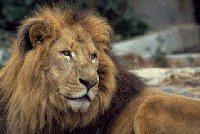 You
have to decide on your own.
You
have to decide on your own.